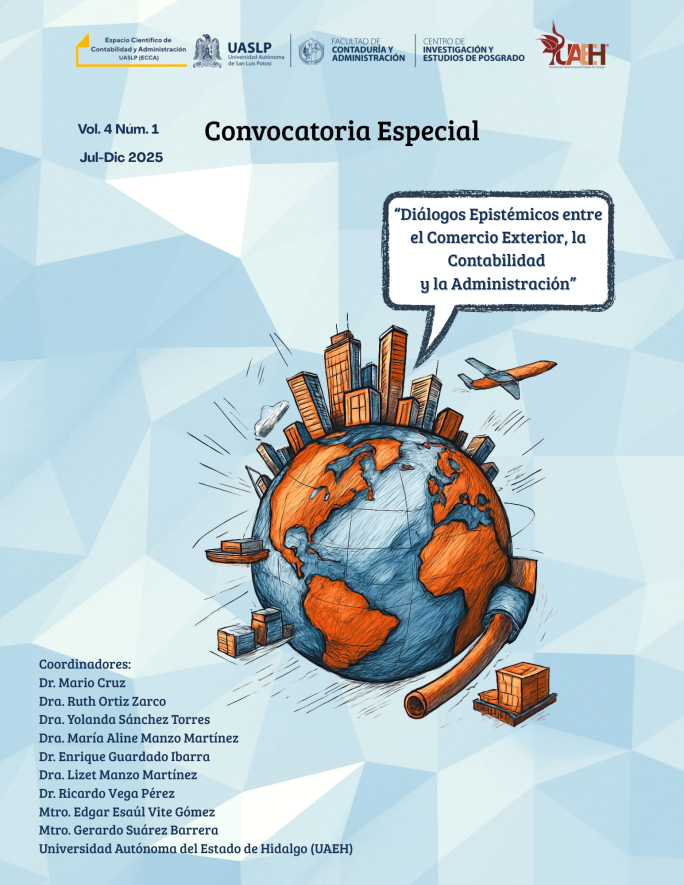The Gamification and artificial intelligence in teaching accounting to marketing students
University Classroom Experiences
DOI:
https://doi.org/10.58493/ecca.2025.3.2.11Keywords:
gamification, teaching of marketing technology, motivation, reprobation, Academic performance, Artificial intelligencesAbstract
Gamification has emerged as an innovative and necessary educational strategy in various educational fields, including the teaching of marketing, Artificial Intelligences are here to stay, it is up to university teachers to use them in a planned way and under ethical rigor, This exploratory study analyzes how the implementation and continuity of playful elements in the teaching-learning process influences the motivation, commitment and academic performance of students. Through a systematic and critical review of the literature and a case study at a university, it has significant benefits, points out challenges, recommendations, engineering for PROMPT. It is concluded that gamification, when implemented in a strategic and reflective way, can enrich the teaching of accounting and marketing and prepare students to face the challenges of the environment, we are the teachers at the axis of change to permeate these gamification and AI activities in the academies of our universities.
References
Amado-Salvatierra, H., & Hernández Rojas, M. (2022). Gamificación y aprendizaje activo: implicaciones para la educación superior en América Latina. Revista Electrónica Educare, 26(1), 1–22. https://doi.org/10.15359/ree.26-1.27
Anthropic. (2024). Claude goes to college and wants to be your study buddy. TechRadar. https://www.techradar.com/computing/artificial-intelligence/claude-goes-to-college-and-wants-to-be-your-study-buddy
Brown, T., & Green, A. (2023). Implementing Classcraft in higher education: A case study. Journal of Educational Gaming, 18(2), 112-125. https://doi.org/10.1080/21532974.2023.1856789
DeepSeek. (2025). DeepSeek: Plataforma de inteligencia artificial para la educación superior. https://www.deepseek.com/
Domínguez, A., Saenz-de-Navarrete, J., de-Marcos, L., Fernández-Sanz, L., Pagés, C., & Martínez-Herráiz, J. J. (2021). Gamifying learning experiences: Practical implications and outcomes. Computers & Education, 182, 104426. https://doi.org/10.1016/j.compedu.2022.104426
Fredricks, J. A., Blumenfeld, P. C., & Paris, A. H. (2004). School engagement: Potential of the concept, state of the evidence. Review of Educational Research, 74(1), 59–109. https://doi.org/10.3102/00346543074001059
Google AI. (2024). Google AI Experiments: Exploring machine learning through interactive projects. Journal of Educational Technology & Society, 27(4), 89-102. https://doi.org/10.1177/00472395221123457
Garg, S. (2024). Writesonic: Conversational Artificial Intelligence. Wiley. https://
González, M., & Pérez, L. (2023). Socrative: A tool for formative assessment in higher education. Journal of Educational Technology Systems, 52(1), 45-60. https://doi.org/10.1177/00472395221123456
Gardner, H. (1983). Frames of mind: The theory of multiple intelligences. Basic Books.
Goleman, D. (1995). Emotional intelligence: Why it can matter more than IQ. Bantam Books.
Hamari, J., Koivisto, J., & Sarsa, H. (2016). Does gamification work? A literature review of empirical studies on gamification. Proceedings of the 47th Hawaii International Conference on System Sciences, 3025–3034. https://doi.org/10.1109/HICSS.2014.377
Lara, D., & Gómez, M. (2023). Aplicación de la gamificación en el aula universitaria: una experiencia en el área de mercadotecnia. Revista Iberoamericana de Educación Superior, 14(41), 81–101. https://doi.org/10.22201/iisue.20072872e.2023.41.1393
Lebbe, S., & Alzetta, J. (2023). Wooclap: Make Learning Awesome & Effective. Wooclap. https://www.wooclap.com
M. Pascual Cabrerizo (2022) GAMIFICACIÓN EN LA EDUCACIÓN SUPERIOR - ¡PORQUE LOS JUEGOS NO TIENEN LÍMITE DE EDAD!, Actas de EDULEARN22 , pág. 7182. doi: 10.21125/edulearn.2022.1682
Martínez, F., & García, P. (2023). Enhancing Moodle with AI plugins: Implications for personalized learning. Computers in Education, 172, 104268. https://doi.org/10.1016/j.compedu.2021.104268
OpenAI. (2024). ChatGPT: A conversational AI model for educational applications. Journal of Educational Computing Research, 62(1), 1-15. https://doi.org
OpenAI. (2025). Actividad tipo escape room digital para enseñar contabilidad a estudiantes de mercadotecnia [Generado por inteligencia artificial]. ChatGPT. https://chat.openai.com/
Pérez, J. A., & Torres, L. M. (2020). Estrategias didácticas innovadoras en educación superior: La gamificación como alternativa. Educación y Ciencia, 25(2), 105–120. https://doi.org/10.32870/educien.v25i2.1046
Ramírez Ruiz, J. J., Vargas Sanchez, A. D., & Boude Figueredo, O. R. (2024). Impact of gamification on school engagement: A systematic review. Frontiers in Education, 9. https://doi.org/10.3389/feduc.2024.1466926
Rodríguez, M. (2025). El decálogo del ejecutivo proactivo en empresas familiares y sus 7
sentidos. Sapiendus, e.8, 1(1). https://doi.org/10.70335/sapiendus.1.1.8
Rodríguez, M. [mtrardzoliva]. (s.f.). Página profesional de Facebook [Página de Facebook]. Facebook. https://www.facebook.com/mtrardzoliva
Smiderle, R., Rigo, S. J., Marques, L. B., Coelho, J. A. P. M., & Jaques, P. A. (2020). The impact of gamification on students’ learning, engagement and behavior based on their personality traits. Smart Learning Environments, 7(3). https://doi.org/10.1186/s40561-019-0098-x
Smith, J., & Johnson, R. (2022). Enhancing vocabulary acquisition through Quizlet: A study in higher education. Language Learning & Technology, 26(3), 75-89. https://doi.org/10.1016/j.linged.2022.03.002
Towers-Clark, C. (2024). Khan Academy: An AI revolution in education or threat to human skills? Educational Technology Research and Development, 72(2), 345-360. https://doi.org/10.1007/s11423-024-10012-5
Vyond. (2024). Vyond Go | Generative AI Script and Video Creator. https://www.vyond.com/
Vallerand, R. J., Pelletier, L. G., Blais, M. R., Brière, N. M., Senécal, C., & Vallières, E. F. (1992). The Academic Motivation Scale: A measure of intrinsic, extrinsic, and amotivation in education.
Educational and Psychological Measurement, 52(4), 1003–1017. https://doi.org/10.1177/0013164492052004025
Kovacs, Z., Szabo, K., & Kovacs, D. M. (2024). Colossyan: AI-powered corporate training videos. Colossyan.
Sánchez-Vera, M. M., & Prendes-Espinosa, M. P. (2021). La gamificación como metodología para la enseñanza universitaria. RED. Revista de Educación a Distancia, 21(67), 1–18. https://doi.org/10.6018/red.467711
Wang, A. I., & Tahir, R. (2022). The effect of using Kahoot! for learning – A literature review. Computers & Education, 159, 104001. https://doi.org/10.1016/j.compedu.2020.104001

Downloads
Published
Issue
Section
License
Copyright (c) 2025 Maria Guadalupe Rodriguez Oliva

This work is licensed under a Creative Commons Attribution-NonCommercial-ShareAlike 4.0 International License.
Usted es libre de:
- Compartir — copiar y redistribuir el material en cualquier medio o formato
- Adaptar — remezclar, transformar y construir a partir del material
- La licenciante no puede revocar estas libertades en tanto usted siga los términos de la licencia
Bajo los siguientes términos:
- Atribución — Usted debe dar crédito de manera adecuada , brindar un enlace a la licencia, e indicar si se han realizado cambios . Puede hacerlo en cualquier forma razonable, pero no de forma tal que sugiera que usted o su uso tienen el apoyo de la licenciante.
- NoComercial — Usted no puede hacer uso del material con propósitos comerciales .
- CompartirIgual — Si remezcla, transforma o crea a partir del material, debe distribuir su contribución bajo la la misma licencia del original.
- No hay restricciones adicionales — No puede aplicar términos legales ni medidas tecnológicas que restrinjan legalmente a otras a hacer cualquier uso permitido por la licencia.












